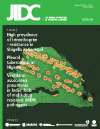Ventilator-associated pneumonia in a tertiary care hospital in India: role of multi-drug resistant pathogens
DOI:
https://doi.org/10.3855/jidc.634Keywords:
Ventilator-Associated Pneumonia, etiology of VAP, multidrug resistant pathogens, AmpC-β-lactamaseAbstract
Background: Ventilator-Associated Pneumonia (VAP) is the most frequent intensive-care-unit (ICU)-acquired infection. The aetiology of VAP varies with different patient populations and types of ICUs.
Methodology: A prospective study was performed over a period of 15 months in a tertiary care hospital to determine the various aetiological agents causing VAP and the prevalence of multidrug resistant (MDR) pathogens. Combination disk method, Modified Hodge test, EDTA disk synergy (EDS) test and AmpC disk test were performed for the detection of extended spectrum beta-lactamases (ESBL), carbapenemases, metallo-beta-lactamases (MBL) and AmpC β-lactamases respectively.
Results: Enterobacteriaceae, Haemophilus influenzae, Staphylococcus aureus, Streptococcus pneumoniae, Candida spp. were more common in early-onset VAP, while non-fermenters (Pseudomonas spp. and Acinetobacter spp.) were significantly associated with late-onset VAP (P value 0.0267, Chi-square value 4.91). Thirty-seven (78.7%) of the 47 VAP pathogens were multidrug resistant. ESBL was produced by 50% and 67% of Escherichia coli and Klebsiella pneumoniae respectively. MBL was produced by 20% of P. aeruginosa. AmpC beta-lactamases were produced by 33.3% and 60.7% of the Enterobacteriaceae and non-fermenters respectively. Of the S. aureus isolates, 43% were methicillin resistant. Prior antibiotic therapy and hospitalization of five days or more were independent risk factors for VAP by MDR pathogens.
Conclusions: VAP is increasingly associated with MDR pathogens. Production of ESBL, AmpC beta-lactamases and metallo beta-lactamases were responsible for the multi-drug resistance of these pathogens. Increasing prevalence of MDR pathogens in patients with late-onset VAP indicate that appropriate broad-spectrum antibiotics should be used to treat them.
Downloads
Published
How to Cite
Issue
Section
License
Authors who publish with this journal agree to the following terms:
- Authors retain copyright and grant the journal right of first publication with the work simultaneously licensed under a Creative Commons Attribution License that allows others to share the work with an acknowledgement of the work's authorship and initial publication in this journal.
- Authors are able to enter into separate, additional contractual arrangements for the non-exclusive distribution of the journal's published version of the work (e.g., post it to an institutional repository or publish it in a book), with an acknowledgement of its initial publication in this journal.
- Authors are permitted and encouraged to post their work online (e.g., in institutional repositories or on their website) prior to and during the submission process, as it can lead to productive exchanges, as well as earlier and greater citation of published work (See The Effect of Open Access).








